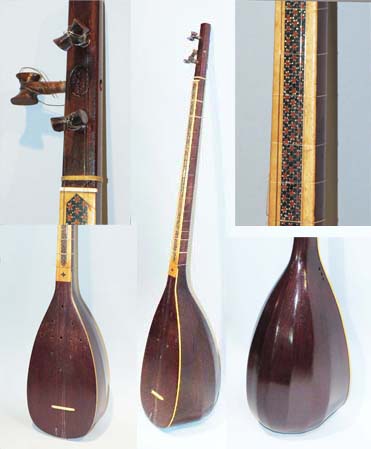
Owner: HWMC
Catalog#: 2ME-CHLT-20
Lutes
Iran ‘Kurdish Tembur’ (Lute)
Iran, Iraq
Kurdish
Mulberry Wood, metal strings, nylon strings, bone
Mid-20th century
Length: 33 in; Width: 6 in; Depth: 5.75 in
Chordophones – Lutes
The Kurdish tembur (tanbur) is associated with the Ahl-e Haqq sect in Kurdish areas of Iran and Iraq, and particularly in Lorestan, a province of western Iran in the Zagros Mountains. This Kurdish tembur consists of a pear-shaped resonator of mulberry wood and a wooden soundtable with eleven small drilled soundholes in the shape of a diamond directly under the strings. The wooden neck is of walnut with the fret board decorated with a colorful inlaid tessellation of 6 pointed stars and triangles. There is trimming by a strip of lighter wood around the rim of the resonator and neck. It has the usual 14 frets with six made of a beige fiber and the remaining eight of nylon. There are three metal strings, the two highest strings are doubled and a drone string. The T-shaped tuning pegs are located with two in front and one on the side of the peghead. The strings are played with all five fingers of the right hand, producing a continuous tremolo effect. Near the top of the neck, there is a small carving of the maker’s signature.
The Kurdish tembur is reserved solely for sacred music, hence its repertory is the most secret and inaccessible musical tradition of the Middle East.
Resource: “Tanbur,” John Baily, Jean During/R. “The Grove Dictionary of Musical Instruments.” 2nd ed. Vol. 4. Laurence Libin, Editor in Chief. Oxford University Press.
